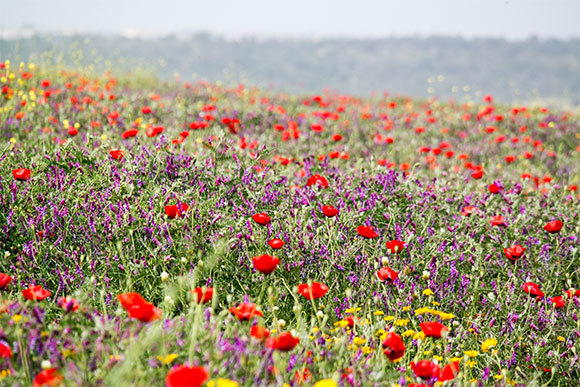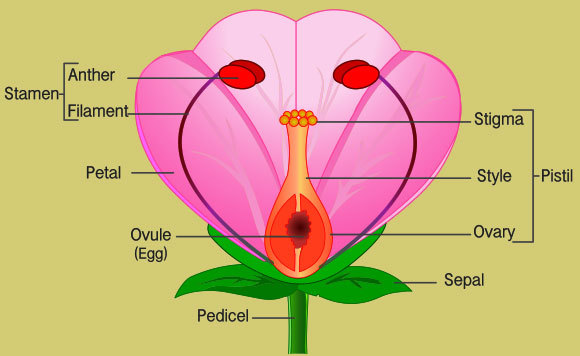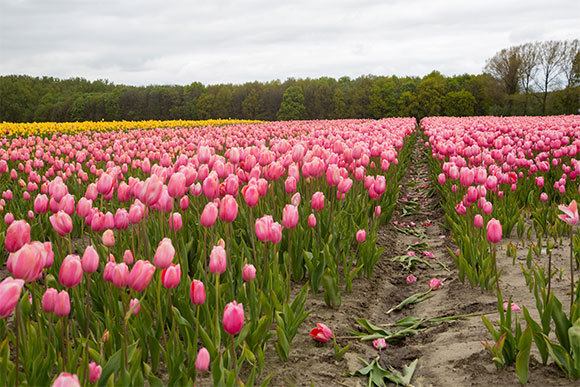The spectacular colors, the intoxicating fragrance and the variety of shapes of flowers are meant to attract the eye and the sense of smell. It is no wonder that they became a symbol for love and romance.
They are spectacularly beautiful, come in a variety of colors and in a wide variety of shapes and sizes, and often have intoxicating and pleasant scents. They can cover large areas with spectacular blossoms and grow in our backyard, in the jungle and in the desert. In 21st century culture flowers have become an essential part of our gifts to one another, in the design of our weddings and festivities and in the daily decoration of our homes. And, needless to say, for many years we have been using flowers to express love and romance. In honor of the spring season, we set out to the fields, to gaze upon the colorful carpets and discuss the science of flowers.

Colorful carpets of wild flowers near Kibbutz Dalia, Israel | Ilya Zuskovich, Shutterstock
When Plants Look for a Match
It is customary to divide the plant world into two groups that differ in their methods of reproduction. The first group are gymnosperms, which are considered evolutionarily older and initially evolved ca. 360 million years ago. In such plants, for example pine trees, the pollen and ovules are not located within a reproductive organ but remain exposed. Flowering plants belong to a younger group, angiosperms, which initially evolved ca. 140 million years ago. Their reproductive organs evolved so as to protect their seeds, and they have gradually developed a wide variety of methods and physiological structures that help the flowers fulfill their function. The flower, thus, is the reproductive organ of plants and can be female, male or both.
The flower is a rather complex organ. Unlike most parts of a tree that are uniform in structure, such as roots or leaves, a flower has many organs. This complexity allows, among other things, for the spectacular appearance that many flowers present. The main organs of the flower are the petals, sepals, stamen and the ovary. The petals are the most prominent organ in the flower, and their main role is to protect the flower's reproductive organs and to attract pollinators for reproduction.
The shape and origin of flowers were a mystery that preoccupied the father of the theory of evolution, Charles Darwin. “I do not think anything in my scientific life has given me so much satisfaction as making out the meaning of the structure of these plants.” Darwin wrote about Primula flowers in his autobiography.

The flower is composed of many organs. The ovary is the feminine reproductive organ and the stamen is the masculine reproductive organ | grayjay, Shutterstock
The Mission: Attracting Pollinators
Reproduction is an important process for all living beings, which devote a substantial part of their resources to promote their ability to produce offspring. The same is true for plants. The reproduction process of flowering plants is based on pollination through animals that travel from flower to flower and fertilize them. Thus, attracting pollinators is an essential mission for a plant that seeks to reproduce, and in order to succeed in this task, it must therefore invest much resources in the color of its petals and in their shape and scent.
The reproductive process in angiosperm plants occurs when pollen from a stamen of one plant - the male sperm cell - reaches the ovary of another plant - the feminine reproductive organ. The ovaries are located within the flower, where fertilization takes place, leading to the formation of the final products - the seeds. Flowers with both male and female reproductive organs can sometimes self-fertilize and create genetically identical copies of themselves. In this type of flower the fertilization process takes place within the plant itself, with virtually no assistance from pollinators. Instead, the plant relies on wind or uses transport mechanisms that have evolved within the flower.
Pollinating animals reach the flowers to find nectar - a aqueous solution of sugars produced inside the plant’s flowers. While these animals feed on the nectar, pollen latches onto them. When they move on to the next flower, pollen will drop off, fertilizing the ovules within the ovaries. Most pollinators are insects, such as bees, mosquitos, beetles and flies, but certain birds and even some mammals, such as certain types of bats, can also be pollinators. Some flowers spread their pollen independently, using wind or water, but this is an ancient pollination method that is not very common today.

Animals reach the flower when foraging for nectar and transport pollen between flowers along the way. A fly pollinating a flower | Cornel Constantin, Shutterstock
The Common Ancestor of Flowers
For many years botanists have tried to understand how flowers evolved and to decipher what was the first ancient flower. For this purpose, they first studied fossilized flowers, but the information that could be derived from them was limited. Significant progress was made in 2017, when researchers traced common characteristics that were preserved among flowers throughout evolution, and were able to reconstruct the hypothetical structure and appearance of the first ancestral flower, which was the common ancestor of all flowers currently in existence.
Based on their analysis, the researchers concluded that the original flower was both male and female. They also estimated that the flower resembled current day Magnolia flowers. Over millions of years of evolution, flowers have undergone multiple changes. For example, the arrangement of petals seems to have become simpler throughout evolution, compared to the relatively complex structure of the original ancient flower. It is possible that the simpler arrangement confers some sort of advantage to current day flowers.

Researchers estimate that the common ancestor of all flowers resembled this flower, Magnolia grandiflora | Image: Dr. Nick Kurzenko, Science Photo Library
The Colors of Nature
The colors of flowers play a very important role. Colors allow the flower to attract potential pollinators, and in some cases can also deter pests. In order to produce the wide variety of colors we are familiar with today, plants use colorful substances termed pigments. The best known of these is chlorophyll, which confers leaves with their green, but is almost etirely absent in flowers. Flower petals of most plants contain only trace amounts of chlorophyll and they owe their colors to other pigments.
Three major classes of pigments determine the color of most flowers. One group is Betalains, which are responsible, among other things, for the strong red color of beet roots, but also appear in lighter shades; Carotenoids are, among other things, responsible for the yellow-orange shades of Daffodils, Carnations, White Lilies and more; While Anthocyanins produce a wide spectrum of colors, from the purple of eggplants or Petunias to red in other flowers.
Since each type of pigment can produce a wide array of colors, some flowers use this ability to adjust their colors so as to fit to their changing environment. For example, when Lisianthus flowers are exposed to light, they produce more Anthocyanin molecules. As a result, the flower changes its color from a light pinkish purple to a deep purple and can even become almost completely black. Other flowers change their color following pollination to signal their status to potential pollinators. The spectrum of flower colors is so wide that it exceeds the limits of human vision. Bees, for example, are also able to see light in the ultraviolet (UV) range, and, accordingly, many flowers present complex patterns of UV emitting pigments that we cannot see.
Extensive research is currently being conducted on floral pigments, aiming at extending and enriching the range of colors available to the flower industry and creating cultivars with new and surprising shades and colors. Other researchers are trying to decipher the cellular processes that produce the pigments and the factors affecting them.

Anthocyanins confer a wide spectrum of colors, from purple to red. Purple Petunia flowers | Yui Yuize, Shutterstock
A Fragrant Gift
Though there are many flowers that are similar in appearance, there are no two flowers with the same scent. The scent of many flowers is pleasant to us, which makes them such a successful gift - but its main role is to attract as many pollinators as possible, which will disperse its pollen.
The source of the scent is in volatile molecules that the plant produces and releases into the air. The flower makes use of it while attracting certain animals and helps them in locating the nearest flower. Studies demonstrate that the scent of flowers that are pollinated by bees or flies tends to be relatively sweet. In contrast, flowers that aim to attract beetles are characterized by strong and sharp aromas that are less pleasant to the human nose.
The hour of the day is also a significant factor for the flowers to adjust secretion of their scent molecules so as to accommodate the potential pollinator. Flowers whose main pollinator is active at night will produce more scent molecules during night hours - and vice versa. Once a flower is successfully pollinated, its scent will gradually diminish, so as to reduce the competition for potential pollinators with other unpollinated flowers.
The Flowers and Us
Plum trees in Japan have a beautiful blossom, in gentle pink and white, which gives off a sweet and pleasant scent. In order to test how it affects a person’s mental and physical state, researchers have produced plum flower extract and had participants in an experiment smell it. In parallel they have monitored their mental activity and physiological measurements such as pulse rate and blood pressure. It was found that the scent induced a physical and mental reaction that is associated with excitement, compared to the control group who smelled clean air.
In contrast to plum tree flowers, Lavender scent was found to have a reverse physiological effect. Participants who smelled lavender for ten minutes demonstrated a reduction in blood pressure and nerve activity, accompanied by a sense of serenity.

In Holland, growing and exporting flowers is a major part of the economy. Tulips in Holland | Kartouchken, Shutterstock
Flower Engineering
The ornamental flower market bohas a yearly revenue of billions of euros, with its main market being in Europe, and especially the Netherlands - a country that became famous for growing colorful Tulips and that has, until recently, dominated most of the global flower market.
Global flower trade requires speed and resources, such as cooling, to prevent the flowers from opening too soon. One of the largest competitors of the Netherlands in rose export is Kenya. The huge rose farms at the bottom of Mount Kenya demonstrate the complexity of their cultivation process. The plants are maintained under fixed temperature and humidity conditions. At the age of eight weeks their stems are cut for the first time, followed by a period of waiting for more stems to grow. Twenty weeks later they are transplanted to a liquid medium, enriched with different nutrients that simulate rich soil, and are sent on their way. That is where the race against the clock begins, since with each passing day the flowers lose some of their quality. During distribution many flowers are discarded as they do not look good enough.
Facing these challenges creates great incentive for scientists and inventors to find new tools and methods to optimize the cultivation of roses and to improve their quality. A substantial part of the current research is focused on methods of genetic engineering used to produce flowers with stronger colors, sweeter scents and prolonged endurance.
Through the use of genetic engineering one can add a new gene to a plant, deactivate existing genes, or alter the activity of specific genes, so as to change a specific quality of an organism, such as a flower’s scent, color or shape. Great effort has been invested in recent years in the flower industry in the genetic engineering of Roses, which enjoy a particularly high market demand.
In one study, researchers introduced a chrysanthemum with a gene that causes accumulation of the blue pigment Delphinidin, an anthocyanin. By doing so they managed to create blue chrysanthemums that do not exist naturally. Roses that were susceptible to frost damage were inserted with a gene from Barrelclover (Medicago truncatula), which confers resistance to low temperatures, and the yield of Roses grown in cold temperatures was thus increased. In another study, genetic engineering was used to prolong the blooming period of chrysanthemums, as well as their potential period of pollination, resulting in an increase of flower yield.
Nine of every ten plants currently in existence are flowering plants. Flowers surround us from every direction and add beauty and fragrance to the world. The variety of flowers in Israel is large, relative to its area, thanks to our location between different climate zones. The common blossoms in Israel are Iris - especially Coastal Iris and Syrian Iris, Lupin, Wind Flowers (Buttercups), Poppies, Cyclamen, Daffodils and more. These species are joined by hundreds of additional species, many of which are protected and should not be picked.
Whether you received them or gave them as a Valentine’s gift, purchased them to add colors to your home or went out to the fields to enjoy their beauty, flowers are some of nature’s most beautiful products. Scientific studies into flowers are aimed at learning how to protect and maintain flowers, and in doing so, scientists use the insights gained from this research to advance new technologies and medical solutions. If you were lucky enough to receive flowers for Valentine’s Day, remember that you were presented with one of the most special and complex phenomena that nature has to offer.
